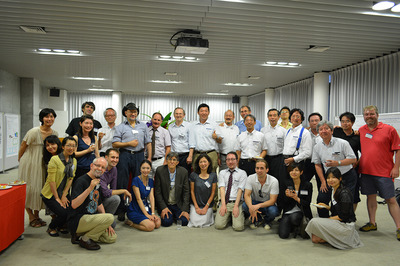ELSI Blog
60 Not-So-Lazy Days of Summer
As Jim Cleaves introduced in the previous blog, this July has been lined with intense weeks for researchers in the Origins of Life study. Yes, the Origins2014 meetings were great and successfully closed in extremely hot Nara. Just after that and the OQOL2014 meetings, ELSI had two big events the following week, our Site Visit and the Tokyo Tech Inspiring Lecture. Actually our ELSI staff members have put a lot of effort into organizing these events during the past few months. Here in this blog, I would like to report on these two ELSI events.
The site visit is an annual report meeting to our funding agency, to present our activities to the Program Committee (PC), Program Director, Program Officer, and Working group members. Within the PC members, there is Dr. Ryouji Noyori who is the president of RIKEN and also a Nobel Prize winner in 2001. Interestingly, we had one more Nobel Prize winner, Dr. Jack W. Szostak, who is one of the PIs of ELSI. Can you believe that? We had two Nobel Prize recipients in a not very big hall! It was a place where the local density of Nobelist was so high it would be easy for an unknowing person to misunderstand that to win the Nobel Prize is not particularly special!
The site visit meeting started with a greeting by the president of our University and followed by the presentations of ELSI PIs and researchers. Especially, the talk by our director, prof. Kei Hirose, was impressive. He emphasized the importance of the scientific activities at ELSI and successfully showed the growing presence of our project not only in Japan but also in the international scientific space. We were able to obtain many positive comments from the Program Committee. Now we clearly feel the positive pressure that our institute is expected to play a global leading role in the Origins of Life research.
The next big event, the Tokyo Tech Inspiring Lecture, was also great. All four speakers, Dr. Szostak, Dr. Sasselov, Dr. Hirose, and Dr. Kirschvink, gave very interesting talks that even the general public would gain knowledge and inspiration from. Especially, the model proposed by Dr. Szostak was remarkable for the study of protocell that is thought to exist before cellular life had emerged on the earth. He explained how the RNA molecules replicate themselves and how the vesicle compartment grows up and divides into small daughter vesicles by its physicochemical property. These steps were effectively explained by using beautiful movies, so that it could be easily understandable and imaginable even for the young high school students present in the audience. I, as a researcher, felt that the next important issue on this research is how to synchronize the vesicle self-division and the RNA replication within the vesicle. This is a big challenge and one of the most difficult points to developing the autonomous living cells.
Finally, I would like to send a big thanks to the Tokyo Tech and ELSI staff members. These events could not be carried out, and especially so smoothly, without their dedication and hard work. THANK YOU!












